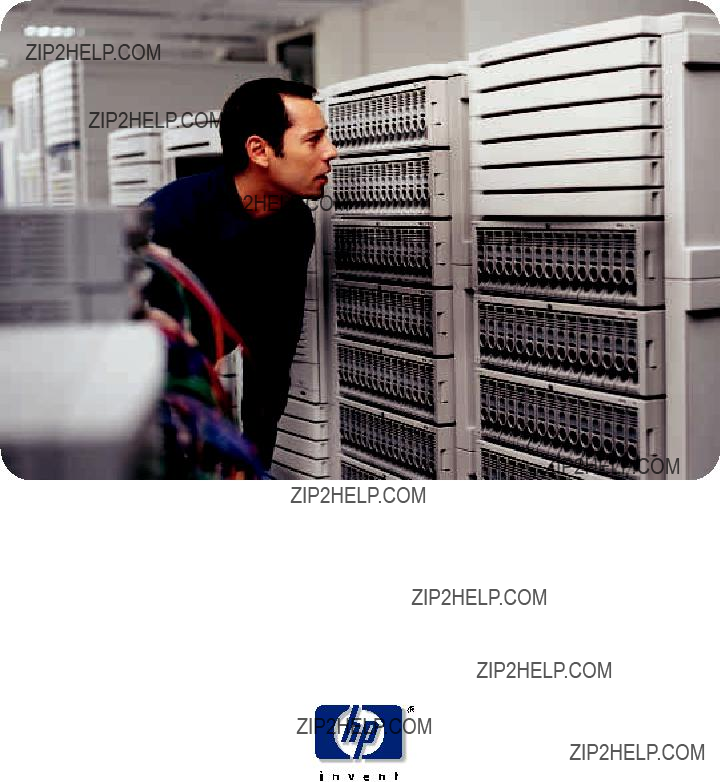
hp virtual array:
double your operating efficiency

hp virtual array:
double your operating efficiency

executive summary
In today???s market environment, you are constantly challenged to find ways to both grow your
business and save costs. And with the current market growth uncertainties, saving costs is getting a lot of attention by everyone from Main Street to Wall Street to inside the Beltway. HP has invented a solution that will get you on the road to saving money and set you up to grow revenue streams once the economy turns around. That solution is HP???s Virtual Arrays.
It may sound complicated at first, but HP???s Virtual Arrays are simply just another automated advancement. They free your organization from the many manual functions required by the current vintage of arrays on the market today. Just as automated printing machines revolutionized the publishing industry in the last century, HP revolutionized the personal and corporate printing industry with its
HP???s Virtual Arrays are automated to maximize your operating efficiencies and maximize your return
on investment. They are automated to save you money.
The following customer quotes and two articles explain how HP???s Virtual Arrays deliver on this
Can you think of even one profitable publishing house that has not fully adopted automated publishing equipment? Can you think of any successful organization that has not adopted laser printing? The same will be said for HP???s Virtual Arrays. Capture these savings today.

table of contents
customer quotes
section22: ???hp extends virtualization to the array???

customer quotes
After seven years and 20,000 sales, we hardly consider
Amazon.comState of New Mexico ???
virtualization new. Many companies have optimized their performance with HP, including:
???We look at three things when selecting data warehouse disks. Price per terabyte, throughput capabilities, and availability features. With the HP Virtual Array 7100, the price per terabyte was extremely competitive and the throughput was phenomenal. Our current Superdome VA7100 configuration is capable of driving three to four gigabytes of I/O per second, and the autoraid features of the VA7100 exceed our availability requirements.???
Mark Dunlap
Director of Data Warehousing
Amazon.com
Room & Board
???In consolidating from eight controllers to the HP Surestore VA7100 we expected to see some performance degradation in running our Children, Youth, and Family Department databases. We haven't seen any degradation and are pleased with the performance. We've found it very easy to allocate space with the VA7100 and have saved time with reduced administrative overhead. With the AutoRAID feature, we've eliminated worrying about mirroring. We let AutoRAID go to work and don't even have to think about it.???
Tom Elder
DBA 3 Children, Youth and Family
Department
State of New Mexico
???After reviewing various competitive scenarios for our SAP environment, we selected HP as our single vendor with rp5450 servers and a VA7100 for our SAN. We found the
John Focht
Systems Administrator
Room & Board
i

customer quotes cont???d
ii
1.0
???data always grows, but human head count
key features of hp???s patented virtual technology
???automatically stripes every LUN across all disks in a very large redundancy group Benefit: simplifies overall management; reduces the number of LUNs required to
???allows any combination of disk drive capacities and speeds within the array Benefit: simplifies disk drive inventory control and capacity management
???allows disk drives and controllers to be moved to any slot in the array
Benefit: reduces the chance for human error
1.1
virtualization1
???The mistakes are all there waiting to be made.???
Data centers have become enormously complex. Interestingly, new technologies that initially held the promise of simplifying the data center have, in fact, added to the
The world is moving from SCSI to Fibre Channel. Fibre Channel and SANs allow for more devices to be connected together, with greater performance, and at far greater distances. All of these are wonderful benefits, but along with those benefits comes an ability to now create configurations that are larger, more complex, further apart, and harder to manage than anything envisioned even a few years ago. Couple this new reality with the exponential increase in storage, fueled by its low cost, and you have a recipe for losing control of the data center.
Consider this: while human resources remain static, environments grow larger and more complex. Simplification is the only realistic answer. Adding newer and slicker management software oftentimes can help, but in the long term, adding software tends to have the opposite effect of reducing complexity. Software may give you a central place from which to manage your hardware and it may simplify processes, but it doesn???t necessarily eliminate those processes. Armed with better management software, environments are encouraged to add more hardware and eventually the environment becomes as complex as it was before, but for different reasons. And when the human resources are already stretched to the breaking point, this is a recipe for complexity, stress, long hours, and human error. Virtualization is the answer. It solves the basic underlying problem. It permanently simplifies the environment for the system administrator.
Configuring and managing traditional storage is
The potential for error is high. The cost of configuring an array improperly is also high. The administrator must consider the following factors:
???capacity, cost, performance and availability requirements
???requirements for future additional capacity and performance
???number of disk drives and their capacity
???performance characteristics of the disks
???which RAID level will meet desired capacity, cost, and availability needs
???number and type of RAID groups
???number of LUNs based on application, performance, and array configuration needs
???size of LUNs
???configuration of the server volume manager
???cache configuration options
???stripe depth configuration
???implementation plan: who, what, and when
???time to bind LUNs
1.2
???desired additional capacity, performance, and availability
???whether the new disks will be stripe extensions of existing disks or be independent groups
here is a typical process for setting up a traditional array:
1.Determine number of disks, number of RAID groups, disks and disk type per RAID group, RAID level of each group, total LUNs, LUNs per RAID group, stripe depth.
2.Determine volume manager configuration, stripe size and depth, LUNs per logical volume.
3.Using the command station, set up the LUNs and their RAID levels and assign them to particular disks.
4.Set up the cache page size depending on the size of the I/Os coming in from the host.
5.Finally, before the new LUNs can be used, disks must be formatted, which can take many hours per array.
configuring an array for a database
Properly configuring an array for a database typically involves a large problem set with many variables. Many database administrators have been taught to isolate different pieces of the database in an attempt to optimize performance, availability, and recovery. This process, although based on sound objectives, is far too
In these
This entire process can take from a few hours to several days, depending on the skill of the administrator and the number and size of the LUNs. During much of this time the array is either unusable or must operate in a degraded performance mode. In other words, LUNs cannot be utilized until they have been formatted. This formatting takes up a lot of the array???s internal resources and bandwidth. After a LUN has been formatted, it can be used; but as long as other LUNs in the array are also going through their format process, the entire array will suffer from degraded performance.
Now, a short word about human error. Every step of this process has the potential for human error. Except in the grossest cases, errors would probably not result in data loss, but every miscalculation in this process would easily result in a decline in performance. Some of these declines could be huge. For example, miscalculating the RAID levels or the cache page size could severely degrade the array???s performance.
1.3
1.4
1.5
1.6
1.7
1.8

Virtualization is a key to solving complexities associated with storage configurations. As Information Technology continues its
SAN virtualization is in effect the aggregation of multiple storage devices in a centralized configuration, a storage pool. This simplifies the storage administrator???s role by enabling all resources to be seen as a single entity. SAN virtualization by itself, however, offers little assistance in efficiently managing requirements of single applications. It pays scant attention to the capacity and performance dynamics of individual, heterogeneous devices within the storage pool. HP, in its Federated Storage Area Management (FSAM) strategy, acknowledges the importance of SAN virtualization. In its VA7000 Series, HP extends these concepts and benefits to the
HP???s VA7000 Series Characteristics
In the HP Surestore VA7000 family, ???virtual array??? refers to treating the disks within the array as a pool of storage blocks rather than as physical disks. With this technology, the VA7000 family emerges as a second tier of storage virtualization. Extending virtualization to the device level, the SAN???s view of storage becomes independent of physical disk attributes. This characteristic reduces the cost associated with SAN virtualization by simplifying storage management, enabling more efficient use of available device capacity, and decreasing the amount of required data movement at the device level.
Our research program in Enterprise Storage Solutions (ESS) makes this Technology Trends available to all our subscribers. Those interested in this program should contact marketing@dhbrown.com or
2.0

absorbed at the array level, without consuming SAN or server resources.
Technology Trends
Copyright ?? 2001 by D.H. Brown Associates, Inc.
2.1

Technology Trends
Copyright ?? 2001 by D.H. Brown Associates, Inc.
2.2

While hardware design and functionality are critical to enabling performance, software function can maximize the efficiency and flexibility of the device. HP???s software packages extend the management and flexibility of the VA7000 family while exploiting the virtualization capability.
HP???s Software for VA7000 Series
Technology Trends
Copyright ?? 2001 by D.H. Brown Associates, Inc.
2.3

section 2???hp extends virtualization to the array???
2
??? Command View SDM speeds and eases local and remote management, including install, configure, monitor, and control via a web browser, direct host attach, or SAN. HP Predictive Support programs and Event Monitoring Service (EMS) provide
??? Smart
HP OpenView Network Node Manager (NNM).
??? Secure Manager Virtual Array (VA) controls server access to data on a
??? Business Copy Virtual Array (VA) supports LUN replication for development, testing, or backup situations. Data replication takes place at a specified point in time while the system is operating and entirely within the storage array, reducing the potential for I/O bottlenecks.
??? Auto Path Virtual Array (VA) routes data around any path???s failure to maximize data availability. It provides the ability to
This document is copyrighted ?? by D.H. Brown Associates, Inc. (DHBA) and is protected by U.S. and international copyright laws and conventions. This document may not be copied, reproduced, stored in a retrieval system, transmitted in any form, posted on a public or private website or bulletin board, or sublicensed to a third party without the written consent of DHBA. NO copyright may be obscured or removed from the paper. All trademarks and registered marks of products and companies referred to in this paper are protected.
This document was developed on the basis of information and sources believed to be reliable. This document is to be used ???as is.??? DHBA makes no guarantees or representations regarding, and shall have no liability for the accuracy of, data, subject matter, quality, or timeliness of the content.
1CA Unicenter TNG and BMC Patrol are supported in addition to the HP OpenView Storage Node Manager, OpenView Allocator, Builder, Optimizer, and Accountant.
Technology Trends
Copyright ?? 2001 by D.H. Brown Associates, Inc.
2.4

06/02